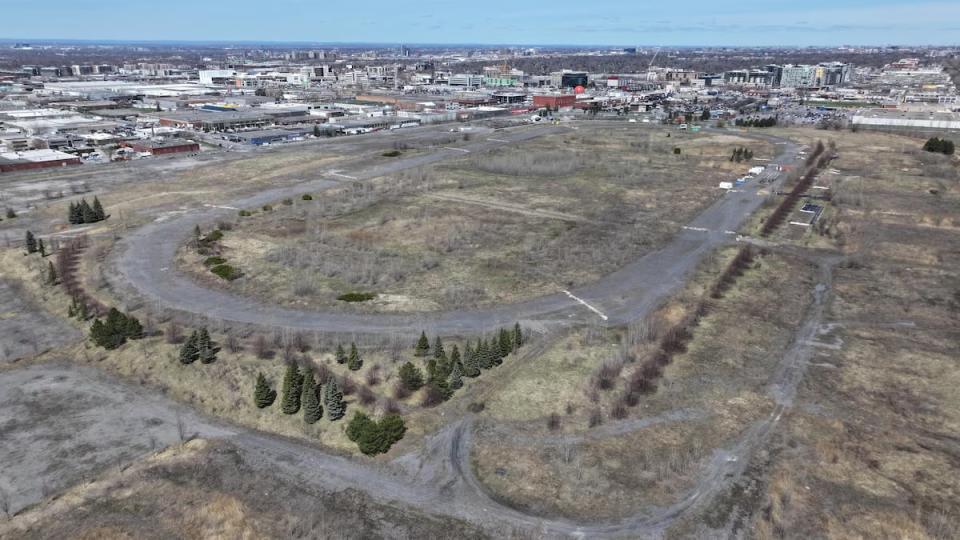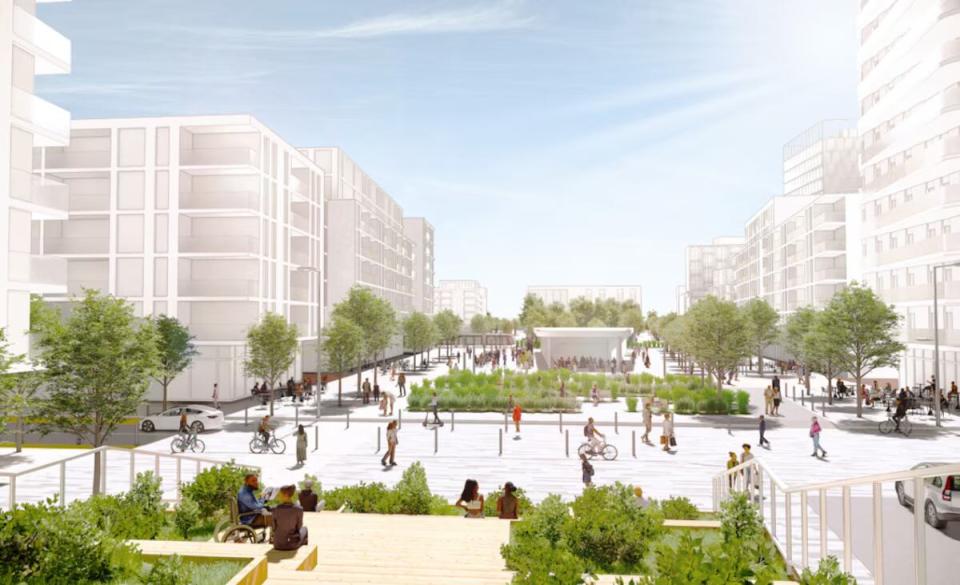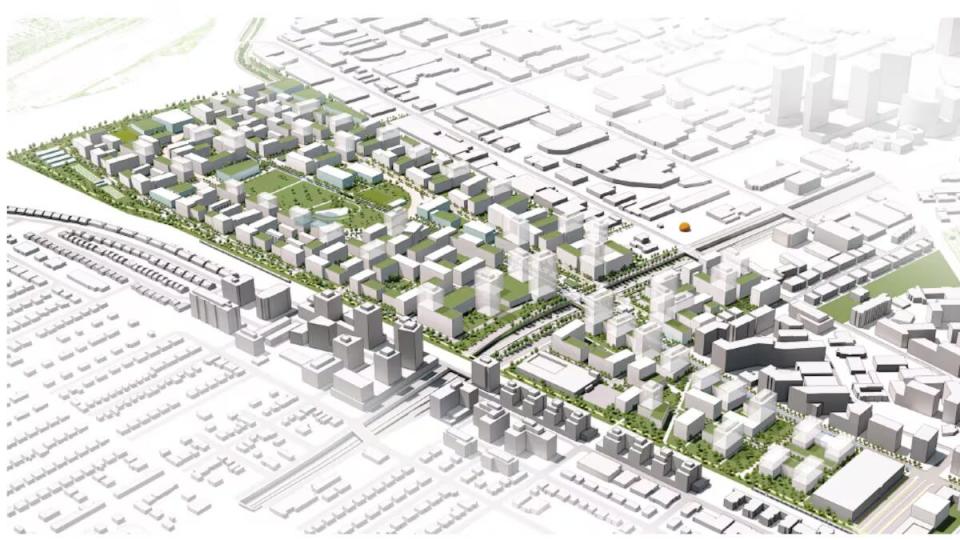Thousands of housing units, tramway in Montreal's new Hippodrome plan

The City of Montreal is planning to build a carbon-neutral district of 20,000 housing units on the site of the former Montreal Hippodrome and land east of the Namur Metro station.
Sandwiched between a railway yard, highway and industrial buildings in northwestern Montreal, the huge swath of land used to house the former Blue Bonnets track, where horses raced for over a century. In 2017, the city acquired the land on the Hippodrome side of the Décarie Expressway from Quebec.
Montreal Mayor Valérie Plante has called the plan Quebec's largest real estate redevelopment project in the past decade.
But skeptics beware, this is not the first time the city announced plans for the empty lot, prompting calls for affordable housing projects while so far failing to ignite interest from developers.
At a news conference on Friday, Plante, along with Quebec Housing Minister France-Élaine Duranceau and federal Housing Minister Sean Fraser each pledged $2 million to Groupe d'accélération pour l'optimisation du projet de l'Hippodrome (GALOPH), a group created to get the construction project moving, to discuss business plans and financing.
"Namur-Hippodrome is a city within a city. It's the equivalent of building a city like Boucherville [or] Rouyn-Noranda within Montreal," said Plante.
The City of Montreal says the new district, named "Namur-Hippodrome," will house up to 40,000 people.

The former site of the Montreal Hippodrome has been sitting empty for years. (City of Montreal)
In its 120-page master plan, the city makes clear that a new tram line on Jean-Talon Street is central to the whole project. It says studies will determine the tramway route, but it may extend all the way to the northern portion of Cavendish Boulevard.
"We are talking about 20,000 homes. There can't be 20,000 new cars here," said Plante.
An ecological, affordable neighborhood
One reason why the project has taken so long to get off the ground, Plante says, is that the city wants to steer clear of repeating mistakes made in other parts of the city — the neighbourhood of Griffintown, for example — where building was done without taking in account access to schools or green spaces.
In contrast, this new district will have parks and public squares. It will also include local businesses and services, health-care facilities, two primary schools and one high school.
According to the plans, the district will be built around a large park with a pond, paths and leisure spaces.
The other reason for the lengthy delay, Plante says, is that the Hippodrome site currently lacks basic infrastructure, therefore requiring substantial investment.
Even so, Plante said the housing will have to be affordable, with half of the housing units "off the market," though she did not provide details about how the city would shield those units from surging rent prices.

The city of Montreal’s plans include lots of greenspaces. (City of Montreal)
Getting developers onboard
In 2022, the city launched a call for tenders to develop the land, but it failed to get developers behind the plan. The call included the obligation to provide 60 per cent affordable condos over 30 years. The minimum bid was $10 million.
According to developers interviewed at the time, real estate market prices, rising construction costs and the regulations for subsidized housing meant that this model was not economically viable for them.
Côte-des-Neiges–Notre-Dame-de-Grâce borough mayor Gracia Kasoki Katahwa says that developers have since been consulted by GALOPH.
"Times are very difficult for promoters. But we worked with them," said Kasoki Katahwa.
She says GALOPH has been working to find ways to make the project attractive as a business venture and has been getting a lot of calls from property owners around Namur Metro station.

The city says it wants to build 20,000 housing units on the site. (City of Montreal)
Roger Plamondon, former president of developer Broccolini and former member of GALOPH's steering committee, says the situation for building now is more favourable than in 2022.
"What is the big difference is that we have taken the time now to prepare an overall plan so that everybody has a buy-in," Plamondon said.
Previously, developers were "reluctant in jumping into an abyss" because they weren't sure what they were getting into, he said.
Michel Leblanc, president of Montreal's Chamber of Commerce, called today's announcement "very significant." He supports the idea of building housing on the site that will remain affordable over time.
However, he says he's still waiting to hear answers to some questions.
"It remains to be seen what will be the logic for the builders," said Leblanc, adding that developers want to know if there are models in place for financing infrastructure and attracting the private sector.
Others are less enthusiastic.
Ensemble Montreal housing critic Julien Henault-Ratelle says housing needs to be built as quickly as possible but a $6-million pledge for more studies after seven years of owning the land isn't good enough from city hall.
"Honestly, it's a joke," said Henault-Ratelle, adding that the city has already had plenty of time to come up with studies already.
Cost and timeline
Pierre Boivin, CEO of Claridge Investments Ltd, says the backing of the Canadian Infrastructure Bank makes the project possible because the city cannot afford all the development costs alone.
He says the project has to move as quickly as possible because of the state of the housing crisis.
"I, today, don't see any reason why we don't have shovels in the ground in 2025," he said.
But how much will it cost?
The master plan does not provide an estimated price tag for the project, but Boivin puts the figure in the billions.
"This is a project that we estimate to be over $8 billion over the 10 years. It's not small money, but it's not all on day one," he said, adding that the different stakeholders will have to work together for each of the building phases to deliver a "feasible plan without deviating from the social objectives."
The City of Montreal has already set aside $300 million over the next 10 years for the new neighbourhood.


